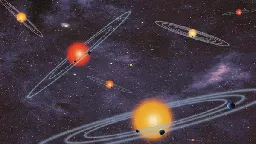Mathematicians find 12,000 new solutions to 'unsolvable' 3-body problem
Mathematicians find 12,000 new solutions to 'unsolvable' 3-body problem

www.space.com
Mathematicians find 12,000 new solutions to 'unsolvable' 3-body problem

Mathematicians find 12,000 new solutions to 'unsolvable' 3-body problem::Calculating the way three things orbit each other is notoriously tricky, but a new study may reveal 12,000 new solutions.
